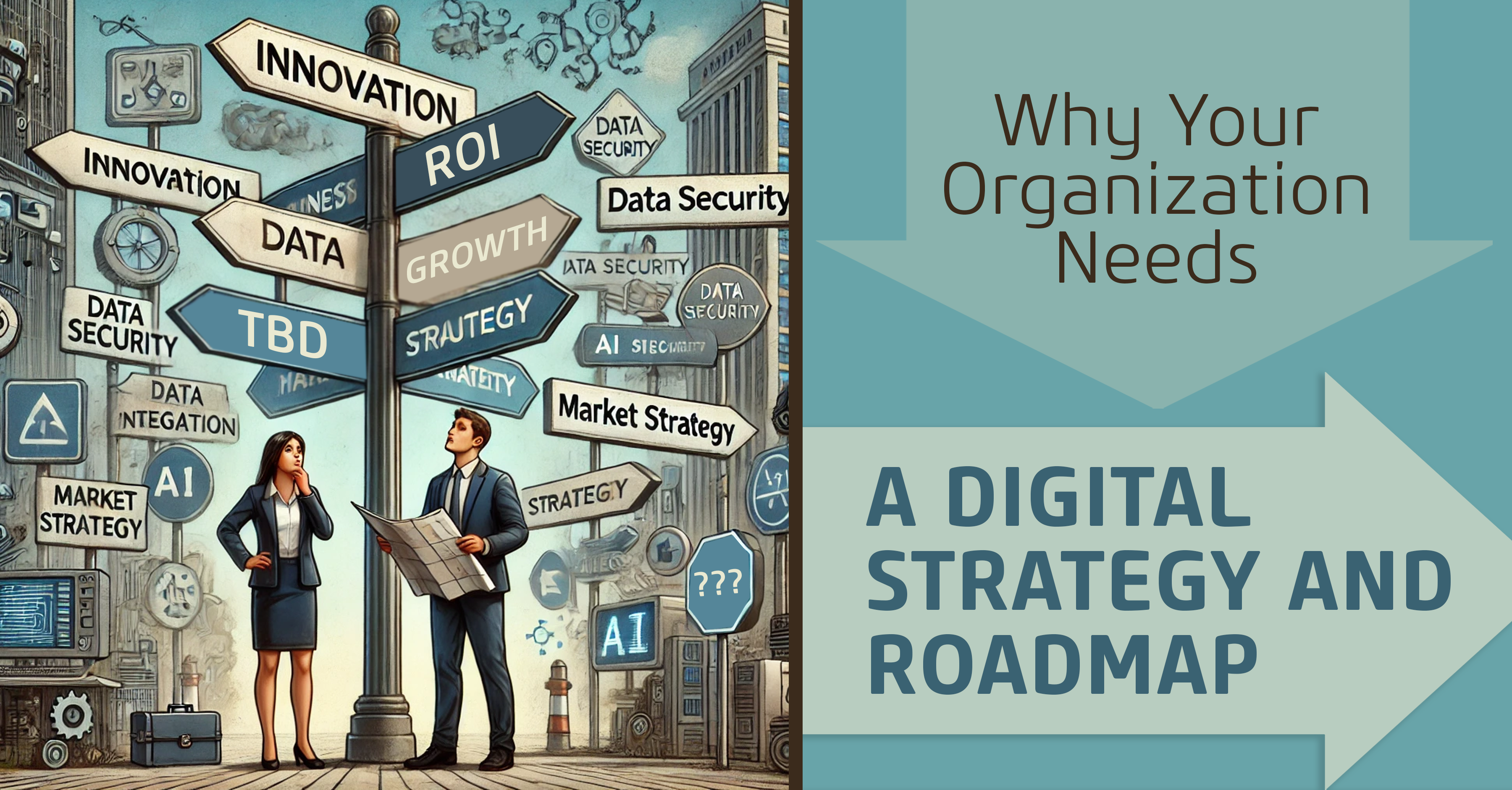Whitney White & Karl Schwab
The intersection of technology and strategy is where organizations either thrive or struggle. The pandemic accelerated digital transformation across industries, pushing companies to adapt quickly to new realities. But, as the dust settles, many are realizing that quick fixes and ad-hoc solutions are not sustainable.
To truly harness the power of digital technologies and ensure long-term success, a well-crafted digital strategy & roadmap is essential. These tools not only align your technology investments with your business goals but also provide a clear, actionable blueprint that guides your organization through its digital transformation journey.
A digital strategy & roadmap serve as interconnected but distinct elements of your transformation journey. The digital strategy outlines your vision and the strategic objectives that guide your organization’s digital initiatives, while the roadmap details the steps, resources, and timelines necessary to achieve that vision.
Together, they ensure your transformation efforts are cohesive and aligned with your business goals. In reality, your digital transformation journey begins with the unification of business and technology stakeholders in the creation of the digital strategy & roadmap. After all, transformation investments are the prerogative of the entire organization—not just IT.

The Critical Role of a Digital Strategy & Roadmap
A digital strategy & roadmap serves as a strategic blueprint that guides your organization’s digital initiatives. It’s more than just a plan; it’s a comprehensive guide that ensures your technology investments directly support your business objectives. But why is this so important? Let’s break it down:
- Alignment with Business Goals
At its core, a digital strategy & roadmap is about alignment. It ensures that every technology investment, from minor system upgrades to major digital transformation projects, is aligned with your overarching business strategy. This alignment is crucial because it prevents the common pitfall of investing in technology for technology’s sake. Instead, it focuses on technology that drives business value, supports growth, and enhances your competitive advantage.
For example, suppose your organization aims to enhance customer experience as a primary business goal. In that case, your digital strategy & roadmap would prioritize initiatives like CRM system upgrades, AI-driven customer support solutions, and personalized marketing technologies. By aligning technology initiatives with business goals, your organization can achieve a cohesive strategy that delivers measurable results.
- De-risking Strategy Execution
Developing and executing a digital strategy can be risky. There are countless variables to consider, from changing market conditions to technological advancements and internal organizational dynamics. A digital strategy & roadmap helps mitigate these risks by fostering collaboration and consensus among key stakeholders.
When stakeholders from different departments contribute to the roadmap, it ensures a comprehensive approach that considers all aspects of the business. This collaborative process identifies potential obstacles, dependencies and gaps early on, allowing for proactive risk management. By having a multi-dimensional focused investment enabler, , your organization can navigate the complexities of digital transformation with greater confidence and fewer surprises.
- Managing Change and Impacts
Digital transformation represents significant changes across the organization—new processes, new tools, and sometimes even a shift in company culture. A digital strategy & roadmap emphasizes what will change, who will be impacted, and when those changes will occur. This level of clarity is vital for managing change effectively.
A well-documented roadmap allows you to communicate the impacts of digital initiatives across the organization. For instance, if a new enterprise resource planning (ERP) system is being implemented, the roadmap will detail how it will affect different departments, the timeline for implementation, and the expected outcomes. This transparency helps in managing expectations and reduces resistance to change, as employees are better informed and prepared for the transition.
- Flexibility and Adaptability
The digital landscape is dynamic, with new technologies and market trends emerging constantly. A static, one-time digital strategy is no longer sufficient. Your digital strategy & roadmap needs to be a living document that evolves with your business and the external environment.
Regular updates and reviews of the roadmap are essential to keep it relevant. This includes revisiting key initiatives, adjusting timelines, and reallocating resources as needed. For example, if a new, disruptive technology enters the market, your roadmap should be flexible enough to incorporate it into your strategy. This adaptability ensures that your organization stays ahead of the curve and can seize new opportunities as they arise.
- Strategic Resource Management
Implementing a digital strategy requires significant resources—financial, human, and technological. A digital strategy & roadmap helps in identifying and managing these resources effectively. They outline the budget requirements, the skills and capabilities needed, and the timeline for acquiring and deploying these resources.
By planning resource allocation carefully, your organization can avoid common pitfalls such as budget overruns, resource shortages, or delays in implementation. Moreover, having a clear understanding of resource needs allows for better coordination between departments, ensuring that everyone is on the same page and working towards the same objectives.
Conclusion: The Time to Act Is Now
In an age where digital transformation is not just an option but a necessity, having a digital strategy & roadmap is crucial for long-term success. It aligns your technology initiatives with business goals, de-risks strategy execution, manages change effectively, and ensures flexibility in an ever-evolving landscape. But most importantly, it provides a clear, actionable plan that guides your organization through the complexities of digital transformation.
The time to act is now. Don’t wait for your competitors to gain the upper hand. Start developing your digital strategy & roadmap today and position your organization for success in the digital age.
If you're ready to take the next step and need expert guidance, consider partnering with professionals who have a proven track record in digital strategy and roadmap development. Your organization’s future depends on it.
About the Authors
 Whitney White
Whitney White
With over 15 years of professional experience, Whitney is a certified Project (PMP) and Business Analysis (CBAP) professional with a passion for people, numbers, systems, projects, data, process improvement, analytics and reporting. She enjoys challenges in both private and public sectors, and is am excited by opportunities that provide an exciting combination of these elements.
Karl Schwab
 Karl is an experienced management consultant with a wealth of expertise spanning 23 years, holding certifications such as Certified Management Consultant (CMC), Project Management Professional (PMP), Certified Business Analysis Professional (CBAP), and Senior Business Strategy Professional (SBSP). In addition, Karl holds an MBA and Bachelor of Science in Engineering from the University of Manitoba.
Karl is an experienced management consultant with a wealth of expertise spanning 23 years, holding certifications such as Certified Management Consultant (CMC), Project Management Professional (PMP), Certified Business Analysis Professional (CBAP), and Senior Business Strategy Professional (SBSP). In addition, Karl holds an MBA and Bachelor of Science in Engineering from the University of Manitoba.
Karl has been operating as senior level advisor at Online Business Systems, where he has served as the Principal and then Director of Digital Advisory Services for the past 10 years leading a dynamic team of professionals specializing in digital strategy and change management. Karl's career is marked by a diverse experience portfolio, having worked across various sectors including transportation, agribusiness, insurance, law enforcement, higher education, healthcare, and multiple non-profit and quasi-governmental organizations, such as Real-estate commissions and Law Societies. His leadership is characterized by a strong focus on developing robust strategies and facilitating effective strategy deployment, ensuring organizational alignment and transformational success.





Submit a Comment